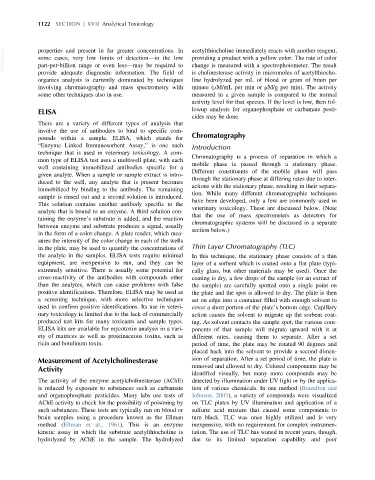Page 1190 - Veterinary Toxicology, Basic and Clinical Principles, 3rd Edition
P. 1190
1122 SECTION | XVII Analytical Toxicology
VetBooks.ir properties and present in far greater concentrations. In acetylthiocholine immediately reacts with another reagent,
providing a product with a yellow color. The rate of color
some cases, very low limits of detection—in the low
change is measured with a spectrophotometer. The result
part-per-billion range or even less—may be required to
provide adequate diagnostic information. The field of is cholinesterase activity in micromoles of acetylthiocho-
organics analysis is currently dominated by techniques line hydrolyzed per mL of blood or gram of brain per
involving chromatography and mass spectrometry with minute (μM/mL per min or μM/g per min). The activity
some other techniques also in use. measured in a given sample is compared to the normal
activity level for that species. If the level is low, then fol-
ELISA lowup analysis for organophosphate or carbamate pesti-
cides may be done.
There are a variety of different types of analysis that
involve the use of antibodies to bind to specific com-
Chromatography
pounds within a sample. ELISA, which stands for
“Enzyme Linked Immunosorbent Assay,” is one such Introduction
technique that is used in veterinary toxicology. A com-
Chromatography is a process of separation in which a
mon type of ELISA test uses a multiwell plate, with each
mobile phase is passed through a stationary phase.
well containing immobilized antibodies specific for a
Different constituents of the mobile phase will pass
given analyte. When a sample or sample extract is intro-
through the stationary phase at differing rates due to inter-
duced to the well, any analyte that is present becomes
actions with the stationary phase, resulting in their separa-
immobilized by binding to the antibody. The remaining
tion. While many different chromatographic techniques
sample is rinsed out and a second solution is introduced.
have been developed, only a few are commonly used in
This solution contains another antibody specific to the
veterinary toxicology. These are discussed below. (Note
analyte that is bound to an enzyme. A third solution con-
that the use of mass spectrometers as detectors for
taining the enzyme’s substrate is added, and the reaction
chromatographic systems will be discussed in a separate
between enzyme and substrate produces a signal, usually
section below.)
in the form of a color change. A plate reader, which mea-
sures the intensity of the color change in each of the wells
in the plate, may be used to quantify the concentrations of Thin Layer Chromatography (TLC)
the analyte in the samples. ELISA tests require minimal In this technique, the stationary phase consists of a thin
equipment, are inexpensive to run, and they can be layer of a sorbent which is coated onto a flat plate (typi-
extremely sensitive. There is usually some potential for cally glass, but other materials may be used). Once the
cross-reactivity of the antibodies with compounds other coating is dry, a few drops of the sample (or an extract of
than the analytes, which can cause problems with false the sample) are carefully spotted onto a single point on
positive identifications. Therefore, ELISA may be used as the plate and the spot is allowed to dry. The plate is then
a screening technique, with more selective techniques set on edge into a container filled with enough solvent to
used to confirm positive identifications. Its use in veteri- cover a short portion of the plate’s bottom edge. Capillary
nary toxicology is limited due to the lack of commercially action causes the solvent to migrate up the sorbent coat-
produced test kits for many toxicants and sample types. ing. As solvent contacts the sample spot, the various com-
ELISA kits are available for mycotoxin analysis in a vari- ponents of that sample will migrate upward with it at
ety of matrices as well as proteinaceous toxins, such as different rates, causing them to separate. After a set
ricin and botulinum toxin. period of time, the plate may be rotated 90 degrees and
placed back into the solvent to provide a second dimen-
Measurement of Acetylcholinesterase sion of separation. After a set period of time, the plate is
removed and allowed to dry. Colored components may be
Activity
identified visually, but many more compounds may be
The activity of the enzyme acetylcholinesterase (AChE) detected by illumination under UV light or by the applica-
is reduced by exposure to substances such as carbamate tion of various chemicals. In one method (Brazelton and
and organophosphate pesticides. Many labs use tests of Johnson, 2003), a variety of compounds were visualized
AChE activity to check for the possibility of poisoning by on TLC plates by UV illumination and application of a
such substances. These tests are typically run on blood or sulfuric acid mixture that caused some components to
brain samples using a procedure known as the Ellman turn black. TLC was once highly utilized and is very
method (Ellman et al., 1961). This is an enzyme inexpensive, with no requirement for complex instrumen-
kinetic assay in which the substrate acetylthiocholine is tation. The use of TLC has waned in recent years, though,
hydrolyzed by AChE in the sample. The hydrolyzed due to its limited separation capability and poor

